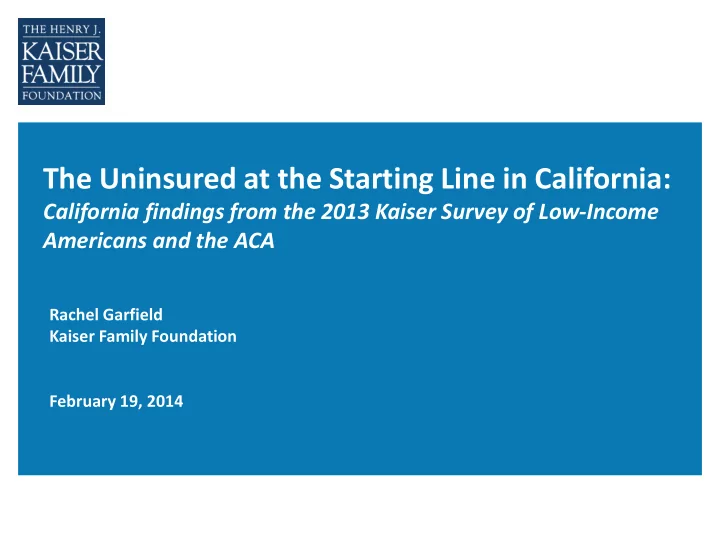

The Uninsured at the Starting Line in California: California findings from the 2013 Kaiser Survey of Low-Income Americans and the ACA Rachel Garfield Kaiser Family Foundation February 19, 2014
Figure 1 Project Overview: Kaiser Survey of Low-Income Americans and the ACA • Aims: – Assess availability and affordability of health coverage for low- and moderate- income populations before and after the ACA – Understand how people use the health care system and whether this changes under the ACA – Track what happens to those who remain uninsured under ACA – Examine how, if at all, the ACA affects families in other ways (such as financial stability, employment, or stress) • Design: – Pre-reform baseline survey & planned follow-up surveys post implementation – National telephone survey paired with parallel, state-specific surveys in CA, MO and TX – Sample includes nonelderly adults (ages 19-64), both insured and uninsured, with oversamples of low- and moderate-income – Baseline survey fielded from July 24 through September 29, 2013 • Pre-ACA sample includes 2,558 California adults
Figure 2 Why focus on ACA Implementation in California? 7 million uninsured residents (15% of • the total US uninsured population) State had an early start on coverage • expansions through Bridge to Reform Medicaid waiver Heavy investment in outreach and • enrollment efforts Highly diverse population presents • challenges and opportunities for outreach and enrollment efforts Reform implemented against • backdrop of other changes to Medicaid, county financing, and market changes
Figure 3 Characteristics of uninsured nonelderly adults in California, 2013 Income Race/Ethnicity Citizenship Undocumented Immigrant >400% 20% FPL Other 8% Race/Ethnicity 22% 139- Hispanic ≤ 138% Legal 400% U.S. 52% FPL Immigrant FPL Citizen White Non- 52% 17% 39% 64% Hispanic 26% NOTE: Includes adults ages 19-64. May not sum to 100% due to rounding. SOURCE: 2013 Kaiser Survey of Low-Income Americans and the ACA.
Figure 4 Previous access to health insurance coverage among uninsured nonelderly adults Share of uninsured nonelderly adults in California who: 82% 50% 24% 22% 17% Have been uninsured Have never had Do not have access to Tried to sign up for Tried to purchase for at least 5 years insurance coverage employer coverage Medi-Cal in past 5 nongroup policy in past years 5 years Source: Kaiser Survey of Low-Income Americans and the ACA, 2013.
Figure 5 What to look for in enrolling and using new coverage Share of nonelderly adults in California who: 46% 38% 35% 20% Found Some Aspect of Found Some Aspect of Needed Service Not Faced Higher Than Medi-Cal Application Plan Choice Process to Covered by Current Expected Costs Under Process to be Difficult* be Difficult** Plan^ Plan^ Enrolling in Coverage Using Coverage * Among those who are currently covered or applied in past 5 years; ** Among insured who had a choice of plans ; ^ Among currently insured Source: Kaiser Survey of Low-Income Americans and the ACA, 2013.
Figure 6 Anticipating service needs and changing patterns as people gain coverage Share of nonelderly adults in California who: Uninsured Employer Coverage Medi-Cal 67% 65% 51% 44% 38% 30% 25% 25% 16% Do not have a usual source of care* Had no preventive care visit in past Have ongoing health condition or take year Rx on regular basis * People who report that they use the emergency room as their usual source of care are counted as not having a usual source of care. Source: Kaiser Survey of Low-Income Americans and the ACA, 2013.
Figure 7 Uninsured adults’ readiness for ACA implementation Share of eligible uninsured nonelderly adults in California who: All Eligible Hispanic Eligible 73% 63% 58% 54% 50% 48% 37% 37% 32% 29% 29% 20% Know "nothing at Know nothing at all Do not have a bank Do not have internet Have no personal Did not have a all" about Medi-Cal* about Covered account access experience with health care visit in California** social service past year programs^ * Among those <138% FPL; ** Among those 139-400% FPL; ^ Includes self or someone else in family receiving Medicaid, food stamps, cash assistance, or disability payments. Notes: “Eligible” includes people with incomes < 400% FPL and excludes undocumented immigrants. Source: Kaiser Survey of Low-Income Americans and the ACA, 2013.
Figure 8 Conclusions and Policy Implications 1. Some eligible uninsured adults in California had little or no connection to the health or social services systems prior to the ACA and may need targeted outreach and education. 2. There is a need for sustained outreach and enrollment efforts to educate people about new coverage options and enrollment processes. 3. There is a high need for coverage among the uninsured population in California, and efforts may be needed to help people navigate the health care system. 4. Careful attention needs to be paid to enrollment barriers beyond website glitches, particularly among the Hispanic population. 5. Clinics and health centers will remain critical providers of care to vulnerable populations under the ACA. Many California providers will continue to be on the front lines of not only service delivery but also outreach and enrollment.
Recommend
More recommend